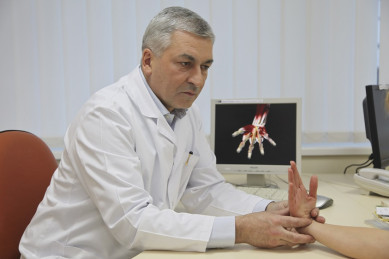2015 10 19
Finger pain and numbness – symptoms of serious diseases
Injuries, Joint Disorders
6 min. skaitymo

The number of people complaining of finger numbness and pain that wakes them up at night and impedes their everyday tasks is increasing. But not everyone seeks medical assistance on time, even though it’s still possible to prevent the progression of the disease and serious complications. We asked the orthopaedist and traumatologist Simonas Sereika of the Medical Diagnostic and Treatment Centre about the symptoms that should make us worry and the cases when surgical treatment is necessary.
– What about finger pain and numbness read in the article with the orthopaedic traumatologist of the Medical Diagnostic and Treatment Centre Dr S.Sereikand and wrist diseases generally make patients ask for your help?
– The patients come about diseases caused by the compression of nerves in the hand – carpal tunnel and elbow tunnel syndromes as well as diseases caused by tendon inflammation – trigger finger, radial styloid tenosynovitis. Carpal joint diseases, formations inside the hand, and subcutaneous palm structure lesions are also common.
Carpal joint pains appear after traumas – they gradually become more intense and start hindering everyday activities. Carpal tunnel syndrome and diseases caused by tendon inflammation are generally diagnosed among women above 50 years of age. There is also another group of patients – young people who perform hard manual labour. After work, they can’t fall asleep at night due to numb and aching fingers. During holidays, they notice that the symptoms have alleviated. Elbow tunnel syndrome affects both women and men above the age of 30. Dupuytren’s contracture, meanwhile, is hereditary and more common in men over the age of 60 who smoke and are involved in manual labour.
– How do the symptoms of these diseases differ?
– With carpal tunnel syndrome, the fingers start to become numb and painful at night. Fingers 1 to 4 are affected; in the morning, they feel stiff but the numbness disappears. As the disease progresses, the numbness remains and things start falling from their hands and it becomes difficult to button up clothes, even though at night the pains might disappear.
Elbow tunnel syndrome generally manifests itself only by numb fingers and more rarely by night-time pain. Fingers 4 and 5 are affected. As the disease progresses, the hand muscles start atrophying and force decreases.
The general symptom of stenosing tenosynovitis (trigger finger) is hand pain. As the person moves the fingers, they start feeling palm pain. The pain spreads to the forearm. As the disease progresses, the finger starts to get stuck. Initially, it might come unstuck by itself, but eventually, manual assistance with another hand is needed to restore it. Sometimes it might stay this way. Generally, fingers 1, 3, and 4 are affected.
With radial styloid tenosynovitis, pain occurs in the area of the wrist, especially when moving the wrist or thumb. The pain becomes more intense. A common cause for this is an unusual physical strain, for instance after chopping wood.
Dupuytren’s contracture manifests itself by a node in the palm under the skin due to cell lesions. Initially, it might be painful; afterwards, the lesions spread to the fingers and these can no longer be extended. Very often, the disease is hereditary, and men get it significantly more often.
A ganglion cyst on the wrist refers to a rounded formation that appears after a sudden twist of the wrist while something is held, or after hard physical strain. It may keep increasing or suddenly disappear and then reappear. This is the main reason why patients visit a hand surgeon about the formation.
Wrist and hand joint diseases are generally complicated and so a comprehensive examination is needed. Lesions of the thumb metacarpal joint are the most common.
– What are the causes of these diseases?
– A heavy physical load is one of the common causes resulting in tendon inflammations, which make the tendons increase and so start traumatizing the surrounding tissues and compressing the nerves. Certain habits can also have an influence – sleeping with the arms sharply bent, leaning on elbows on the desk at work, constant driving with the elbow resting on the armrest. Hormonal changes occurring in the body, such as thyroid diseases or menopause for women, also have some influence. After an earlier trauma, the joints start wearing down faster. The causes of a number of diseases, however, remain unknown.
– What symptoms should serve as grounds for worry?
– It’s always necessary to ask a doctor if the fingers start to become numb, gradually or suddenly. This is a sign of nerve compression. It’s also necessary to seek medical attention when a formation appears and starts growing.
– What are the consequences of a delay in seeking help?
– When patients don’t seek help for nerve compression diseases revealed through finger numbness and pain at night, the damage to the nerve increases – the fingers remain insensitive, the hand muscles start atrophying, and as a result, the force decreases, it becomes difficult to hold small things and the hands are sensitive to cold. Then, even after an operation, the hand functions may not be restored entirely. In the case of a stuck finger, as the disease progresses the finger remains stuck and after an operation, the joint movements may still be limited. When a hand contracture progresses, an operation becomes much more complicated, and even afterwards the movements may still be limited.
– Surgical and conservative treatment of hand and wrist diseases – how are these treatment methods different?
– Usually, the treatment starts with conservative means – a reduction in workload, medicines, splints, and physiotherapy. If these are not effective, an operation is performed.
A complex of treatments is prescribed – a change of working regimen, medicines, splints, and rehabilitation measures such as physiotherapy. If these are not effective, the hand surgeon then decides whether surgical treatment is required. It is important that the patient is not too late. Timely operations are very effective and rather non-complex. As the disease advances, the surgical treatment becomes more complicated and the results are not as good.
Treatment of carpal tunnel syndrome includes the reduction of physical strain on the arm, the prescription of non-steroid anti-inflammatory drugs, B group vitamins improving the nourishment of the nerves and blood circulation as well as vasodilators. A splint for the night is a very effective means but not very popular in Lithuania. Elbow tunnel syndrome is treated by the same medicines and physiotherapy measures. The electroneuromyography examination helps diagnose these diseases and decide on surgical treatment.
I usually start to trigger finger treatment with a blockade by Kenalog. For the treatment of radial styloid tenosynovitis, a splint is prescribed and a hormonal blockade. In the case of wrist and finger joint or tendon ganglions, the formation is punctured. Wrist joint lesions are treated with splints, anti-inflammatory medicines, physiotherapy procedures, and intra-articular injections.
– When is surgical treatment necessary?
– With finger contracture (Dupuytren’s contracture), only surgical treatment is effective. In all other cases, when the above conservative treatment methods don’t help and the symptoms persist or progress, surgical treatment is essential.
– How can the diseases be prevented?
– The main recommendation is to choose physical loads according to your abilities. It’s important not to overexert yourself, and where any symptoms are observed to reduce the load.
Dr. Sereika stresses that after all of the operations the patients are discharged on the same or the next day, whereas the operation costs are compensated by the patients’ funds. So, as soon as you feel the first symptoms, don’t postpone your visit and prevent serious diseases.





